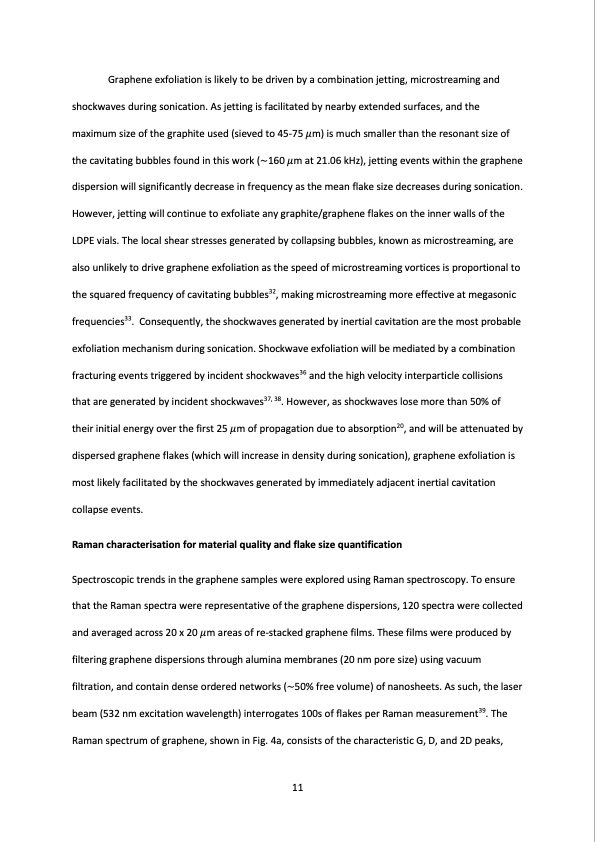PDF Publication Title:
Text from PDF Page: 011
Graphene exfoliation is likely to be driven by a combination jetting, microstreaming and shockwaves during sonication. As jetting is facilitated by nearby extended surfaces, and the maximum size of the graphite used (sieved to 45-75 𝜇m) is much smaller than the resonant size of the cavitating bubbles found in this work (~160 𝜇m at 21.06 kHz), jetting events within the graphene dispersion will significantly decrease in frequency as the mean flake size decreases during sonication. However, jetting will continue to exfoliate any graphite/graphene flakes on the inner walls of the LDPE vials. The local shear stresses generated by collapsing bubbles, known as microstreaming, are also unlikely to drive graphene exfoliation as the speed of microstreaming vortices is proportional to the squared frequency of cavitating bubbles32, making microstreaming more effective at megasonic frequencies33. Consequently, the shockwaves generated by inertial cavitation are the most probable exfoliation mechanism during sonication. Shockwave exfoliation will be mediated by a combination fracturing events triggered by incident shockwaves36 and the high velocity interparticle collisions that are generated by incident shockwaves37, 38. However, as shockwaves lose more than 50% of their initial energy over the first 25 𝜇m of propagation due to absorption20, and will be attenuated by dispersed graphene flakes (which will increase in density during sonication), graphene exfoliation is most likely facilitated by the shockwaves generated by immediately adjacent inertial cavitation collapse events. Raman characterisation for material quality and flake size quantification Spectroscopic trends in the graphene samples were explored using Raman spectroscopy. To ensure that the Raman spectra were representative of the graphene dispersions, 120 spectra were collected and averaged across 20 x 20 𝜇m areas of re-stacked graphene films. These films were produced by filtering graphene dispersions through alumina membranes (20 nm pore size) using vacuum filtration, and contain dense ordered networks (~50% free volume) of nanosheets. As such, the laser beam (532 nm excitation wavelength) interrogates 100s of flakes per Raman measurement39. The Raman spectrum of graphene, shown in Fig. 4a, consists of the characteristic G, D, and 2D peaks, 11PDF Image | Cavitation Liquid Phase Exfoliation of Graphene

PDF Search Title:
Cavitation Liquid Phase Exfoliation of GrapheneOriginal File Name Searched:
1809-07630.pdfDIY PDF Search: Google It | Yahoo | Bing
Salgenx Redox Flow Battery Technology: Power up your energy storage game with Salgenx Salt Water Battery. With its advanced technology, the flow battery provides reliable, scalable, and sustainable energy storage for utility-scale projects. Upgrade to a Salgenx flow battery today and take control of your energy future.
CONTACT TEL: 608-238-6001 Email: greg@infinityturbine.com (Standard Web Page)